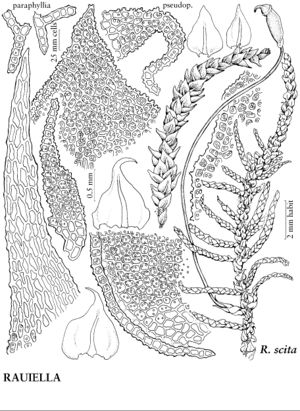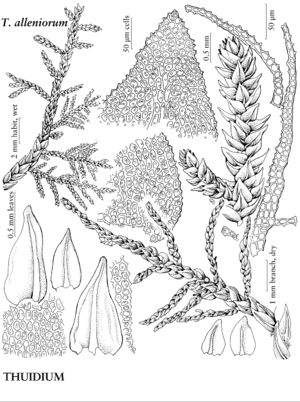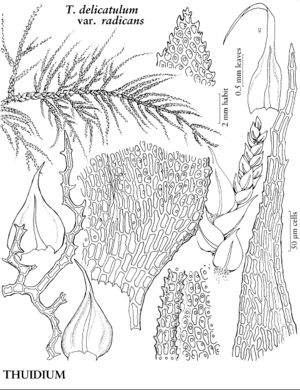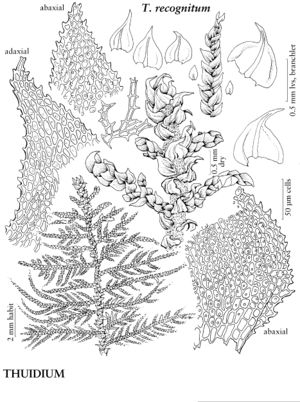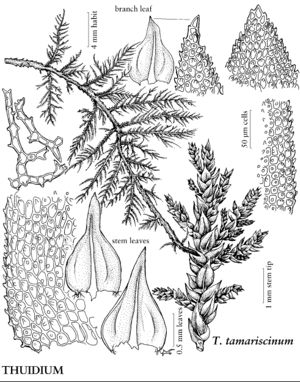Thuidiaceae
Plants small to large, usually in stiff, loose mats, dark green to golden brown. Stems creeping or ascending, usually regularly 1–3-pinnate, not stipitate; hyalodermis absent, central strand small; paraphyllia present, filamentous to foliose, cells papillose; pseudoparaphyllia foliose; axillary hairs usually basal-cell 1, short, brown, distal cells elongate, hyaline (all cells brown in Abietinella). Stem and branch leaves strongly differentiated; margins serrulate to crenulate ± throughout; costa single; alar cells not or poorly differentiated; laminal cells quadrate to short-rectangular, 1- or multipapillose on both surfaces or only abaxially, walls firm. Stem-leaves usually spreading when moist, usually broadly ovate, concave; margins plane or recurved; apex acuminate; costa strong, ending in acumen to ± excurrent. Branch leaves usually spreading, ovate to oblong-ovate, smaller than stem-leaves; margins usually plane; apex usually gradually acuminate to obtuse; costa weaker than in stem-leaves; apical laminal cell usually truncate, multipapillose, walls not porose. Specialized asexual reproduction absent. Sexual condition autoicous or dioicous; perichaetia conspicuous, leaves erect, sometimes plicate, margins plane, apex long-acuminate, costa single, usually strong, laminal cells rectangular, more elongate than in vegetative leaves, usually smooth. Seta reddish, elongate, smooth to roughened throughout or rarely only distally. Capsule usually inclined to horizontal, rarely suberect, usually asymmetric and arcuate; exothecial cell-walls thin to thick, not collenchymatous; annulus differentiated; operculum usually rostrate; peristome hypnoid, double, attached at mouth; exostome teeth bordered, shouldered, external surface cross-striolate basally, sometimes with overlying papillae, internal surface papillose, trabeculate; endostome basal membrane high, segments keeled, not to narrowly perforate, cilia in groups of 1–4, nodulose. Calyptra cucullate, smooth or roughened, naked. Spores spheric, usually papillose.
Distribution
North America, Mexico, West Indies, Central America, South America, Asia, Africa
Discussion
Genera 9, species ca. 130 (4 genera, 11 species in the flora).
Thuidiaceae are characterized by pinnate branching and strongly differentiated stem and branch leaves. The stems are usually amply clothed with paraphyllia, but in smaller plants, paraphyllia are often sparse. The laminal cells of stem and branch leaves are short and papillose.
Haplocladium (referred to Leskeaceae) might be confused with various Thuidiaceae. However, in Haplocladium, the paraphyllia are not papillose (as they are throughout Thuidiaceae) and branch leaves terminate in a smooth, sharp cell, rather than a truncate, multipapillose cell (except in Rauiella praelonga). Thuidiaceae were distilled by W. R. Buck and H. A. Crum (1990), emphasizing sexuality, placement of laminal cell papillae, papillosity of the cells of the paraphyllia, morphology of axillary hairs, and seta ornamentation. More recently, A. Touw (2001) provided a different generic scheme apparently based primarily on knowledge of the Asian flora.
Selected References
None.
Lower Taxa
Illustrations
Key
| 1 | Stems 1-pinnate | > 2 |
| 1 | Stems (1-)2-3-pinnate | > 3 |
| 2 | Plants large; stems erect-ascending; laminal cells 1-papillose; branch leaf costae not covered with cells apically. | Abietinella |
| 2 | Plants medium-sized; stems creeping; laminal cells multipapillose; branch leaf costae covered with cells apically. | Rauiella |
| 3 | Plants small; sexual condition autoicous; paraphyllia unbranched; laminal cells multipapillose on both surfaces. | Cyrto-hypnum |
| 3 | Plants large; sexual condition dioicous; paraphyllia lanceolate or filiform-branched; laminal cells papillose only abaxially, usually 1-papillose. | Thuidium |


